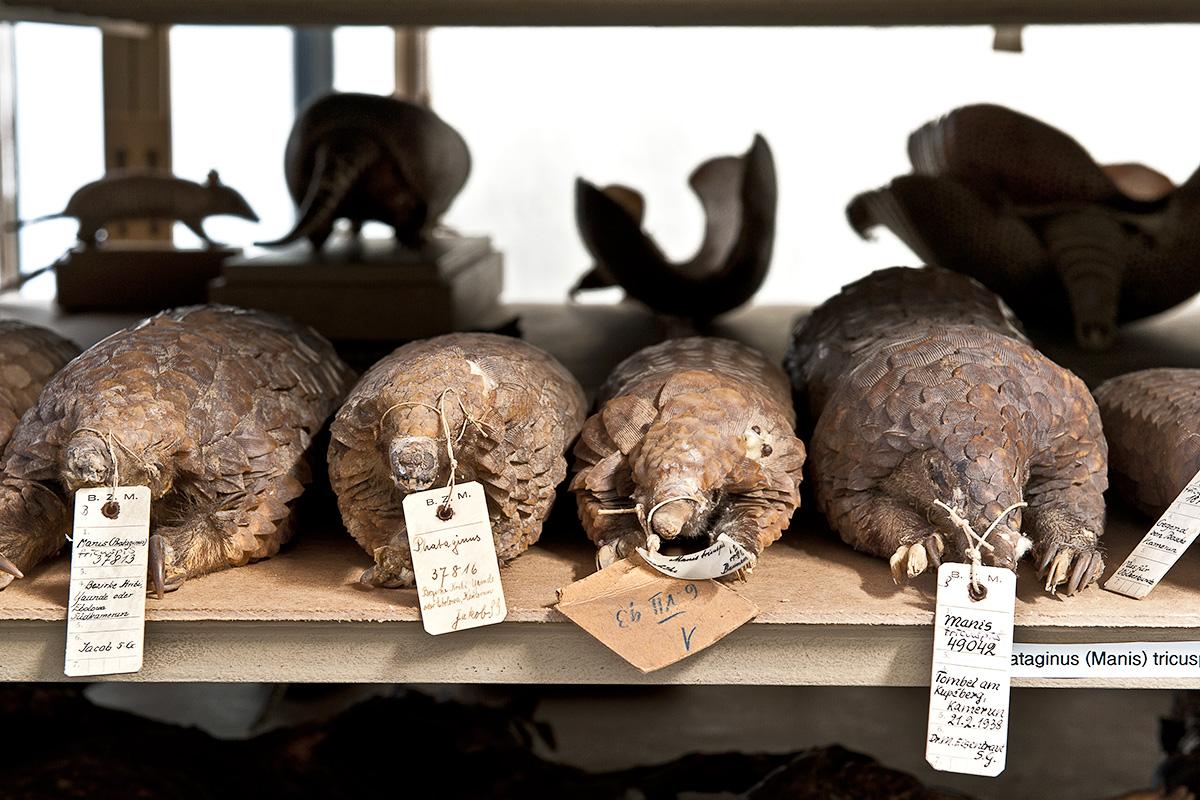Current info: Due to major collection moves and summer holidays, our collection service will be reduced or suspended for the next few weeks. Until end of August we can´t schedule new collection visitors. We apologise for the inconvenience.
---------------------------------------------------------------------------------------------
The Mammals Collection comprises approximately 150,000 specimens, including over 2,000 type specimens. It is one of the world’s largest collection of recent mammals. Its scope encompasses specimens of all 29 mammalian orders, ranging from large collection series of common native small mammals and individual specimens of rare primates to extinct species such as the Tasmanian tiger. One of the geographical foci of the collection is on the former German colonies in Africa.
Approximately 20,000 specimens are preserved in ethanol, while of the others, hides, skulls or skeletons are stored separately. Skulls make up the largest number of collection items. In addition to the dry and wet collections, we are also building up a DNA and tissue collection.
We are currently relocating major parts of our scientific collection, which is combined with an electronic inventory of the collection. Therefore, we currently cannot provide any collection service.
Digitisation
The most important part of the collection was recorded in the SPECIFY database in 2014. Over 105,000 specimens from approximately 79,000 individual mammals have now been digitally recorded (as of May 2016) and can be researched online. This is an ongoing process and those collection items that have not been recorded so far will eventually be included in the database.
History
The Mammals Collection was founded with the intention of representing biodiversity in mammals worldwide. The first specimens date from the early 18th century, including specimens from the Naturalienkabinett (Naturalist Cabinet) of the Königlich Preußischen Akademie der Wissenschaften (Royal Prussian Academy of Sciences) and the Königliche Kunstkammer (Royal Art Chamber). Most of the material was added to the collection in the late 19th and early 20th century – often coming from major, high-profile expeditions. This was a time when there was growing interest in geographical variation and biogeography, which led to the serial collection of individual specimens. The description of new species and variants was all-important until the 1920s, and many type specimens became part of the collection.
Major parts of the collection owe their existence to Alfred Nehring (1845-1904) (comprehensive collection of domestic animals from the 2nd half of the 19th century) and Paul Matschie (1861-1926) (extensive type material from the early 20th century). The most significant expeditions were a naturalist voyage to Mozambique in the 1840s undertaken by Wilhelm Peters (1815-1883), the Duke Adolf F. zu Mecklenburg’s German Central African Expeditions (1907/1908 and 1910/1911) and Ernst Schäfer’s (1910-1992) Tibet-Expedition (1930s).
Research
Publications relating to the Mammals Collection:
- Angermann, R. (1989a) Historische und aktuelle Bedeutung wissenschaftlicher Sammlungen am Beispiel der Säugetiersammlung des Museums für Naturkunde. Wissenschaftliche Zeitschrift der Humboldt-Universität Berlin, Reihe Mathematik/Naturwissenschaften 38 (4): 359-366.
- Angermann, R. (1989b) Die Säugetierkollektion des Museums für Naturkunde der Humboldt- Universität zu Berlin. Säugetierkundliche Informationen 3 (13): 47-68.
- Giere, P. und S. Jancke (2010) Professor Georg Friedrich Paul Matschie. In: Damaschun, F., S. Hackethal, H. Landsberg und R. Leinfelder (Hrsg) Klasse, Ordnung, Art – 200 Jahre Museum für Naturkunde Berlin, Basilisken-Presse, Rangsdorf: 196-199.
- Jancke, S., D. Striebing und F. Mayer (2015) Exploitation of digital collection data at the Museum für Naturkunde Berlin. Journal of Natural Science Collections 2: 41-46.
- Turni, H., R. Hutterer und R. Asher (2007) Type specimens of “insectivoran” mammals at the Museum für Naturkunde, Berlin. Zootaxa 1470: 1–33.
- Turni, H. und D. Kock (2008) Type specimens of bats (Chiroptera: Mammalia) in the collections of the Museum für Naturkunde, Berlin. Zootaxa 1869: 1–82.
Library
The Mammals Department also includes a library section with specialist journals, monographs and reprints.
